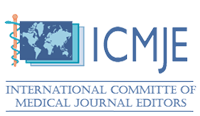КЛИНИКО-ЛАБОРАТОРНЫЕ ОСОБЕННОСТИ ИММУННОГО ОТВЕТА У ДЕТЕЙ С ИНФЕКЦИЕЙ COVID-19
Аннотация
В статье представлены результаты анализа клинико-морфологической характеристики и ряда показателей периферической крови у детей с новой коронавирусной инфекцией.
Цель исследования – дать клинико-лабораторную характеристику иммунного ответа у детей с новой коронавирусной инфекцией.
Материалы и методы. Обследовано 102 детей с новой коронавирусной инфекцией. Оценка показателей периферической крови и субпопуляций лимфоцитов у детей трех возрастных групп 0-4 лет, 5-9 лет и 10-14 лет.
Результаты. У детей с новой коронавирусной инфекцией наблюдается дисбаланс гранулоцитарного и лимфоцитарного звена, наиболее выраженный для детей младшего (0-4 года) и среднего (5-9 лет) возрастной групп. Общая тенденция изменений характеризуется повышением лимфоцитов и гранулоцитов в начале заболевания и снижение через 2 недели. Коэффициент соотношения нейтрофилов к лимфоцитам демонстрирует преобладание нейтрофилов.
Заключение. Наше исследование продемонстрировало, что при острой фазе вирусной инфекции COVID-19 у детей происходит увеличение содержания нейтрофилов, относительно содержания лимфоцитов. При анализе показателей субпопуляций лимфоцитов у детей было установлено снижение Т-цитотоксических лимфоцитов (CD3+CD8+), NK-лимфоцитов (CD16+CD56+) и В-лимфоцитов (CD19+) относительно нормы. Исследования дают важные клинические данные во время продолжающейся пандемии.
Скачивания
Литература
Список литературы
Губенко Н.С. Связь показателей общего анализа крови с тяжестью течения COVID-19 у госпитализированных пациентов / Н.С. Губенко, А.А. Будко, А.Г. Плисюк // Южно-Российский журнал терапевтической практики. 2021. Т. 2(1). С. 90-101. https://doi.org/10.21886/2712-8156-2021-2-1-90-101
Заболевание COVID-19 у детей и подростков. Научная справка 29 сентября 2021 г. https://apps.who.int/iris/bitstream/handle/10665/345575/WHO-2019-nCoV-Sci-Brief-Children-and-adolescents-2021.1-rus.pdf (дата обращения: 15.03.2023)
Клинико-лабораторная характеристика тяжелых форм новой коронавирусной инфекции / Ж. Б. Понежева, А. А. Гришаева, Л. К. Алимова, и др. // Терапия. 2022. №3. С. 7-13. https://dx.doi.org/10.18565/therapy.2022.3.7-13
Сухомлинова И. М. Клинико-лабораторные и инструментальные предикторы эффективности противовоспалительной терапии при COVID-19 / И. М. Сухомлинова, И. Г. Бакулин, М. Ю. Кабанов // Вестник Северо-Западного государственного медицинского университета им. И.И. Мечникова. 2022. Т. 14, № 3. C. 53-60. https://doi.org/10.17816/mechnikov109536
Aberdein J.D., Cole J., Bewley M.A., Marriott H.M., Dockrell D.H. Alveolar Macrophages in Pulmonary Host Defence the Unrecognized Role of Apoptosis as a Mechanism of Intracellular Bacterial Killing // Clin. Exp. Immunol. 2013. Vol. 174. P. 193–202.
Antibody response in children with multisystem inflammatory syndrome related to COVID-19 (MIS-C) compared to children with uncomplicated COVID-19 / A. Thiriard, B. Meyer, C.S. Eberhardt, et al. // Front. Immunol. 2023. Vol. 14. P. 1107156. https://doi.org/10.3389/fimmu.2023.1107156
Blood neutrophils from children with COVID-19 exhibit both inflammatory and anti-inflammatory markers / V. Seery, S.C. Raiden, S.C. Algieri, at al. // EBioMedicine. 2021. Vol. 67. P. 103357.
Children and young people remain at low risk of COVID-19 mortality / S. B. Sunil, B. Jayshree, O. Bayanne, B. Raj. 2021. https://doi.org/10.1016/ S2352-4642(21)00066-3
Clinical features of patients infected with 2019 novel coronavirus in Wuhan, China / C. Huang, Y. Wang, X. Li et al. // Lancet. 2020. Vol. 395. P. 497-506. https://doi.org/10.1016/S0140-6736 (20)30183-5
COVID-19 Disease in Under-5 Children: Current Status and Strategies for Prevention including Vaccination / A. Pillai, A. Nayak, D. Tiwari, at al. // Vaccines. 2023. Vol. 11. P. 693. https://doi.org/10.3390/vaccines11030693
COVID-19 in 7780 pediatric patients: a systematic review / A. Hoang, K. Chorath, M. Moreira, et al. // E. Clinical. Medicine. 2020. Vol. 24(100433). https://doi.org/10.1016/j.eclinm.2020.100433
COVID-19 in children and the dynamics of infection in families / K.M. Posfay-Barbe, N. Wagner, M. Gauthey, et al. // Pediatrics. 2020. Vol. 146 (2). e20201576. https://doi.org/10.1542/peds.2020-1576
COVID-19 in children treated with immunosuppressive medication for kidney diseases / M. Marlais, T. Wlodkowski, S. Al-Akash, et al. // Arch. Dis. Child. 2021. Vol. 106. P. 798–801.
COVID-19 in children. II: Pathogenesis, disease spectrum and management / A.R. Howard-Jones, D.P. Burgner, N.W. Crawford, et al. // Journal of Paediatrics and Child Health. 2022. Vol. 58. P. 46–53.
Detection of Covid-19 in Children in Early January 2020 in Wuhan, China. / W. Liu, Q. Zhang, J. Chen, et al. // N. Engl. J. Med. 2020. Vol. 382(14). P. 1370-1371. https://doi.org/10.1056/NEJMc2003717
Effects of Coronavirus Disease 2019 (COVID-19) on Peripheral Blood Lymphocytes and Their Subsets in Children: Imbalanced CD4+/CD8+ T Cell Ratio and Disease Severity / S. Mahmoudi, B. Yaghmaei, M. Sharifzadeh Ekbatani, et al. // Front. Pediatr. 2021. Vol. 9, 643299. P. 1-7. https://doi.org/10.3389/fped.2021.643299
Expansion of CD56dimCD16neg NK Cell Subset and Increased Inhibitory KIRs in Hospitalized COVID-19 Patients / J. L. Casado, E. Moraga, P. Vizcarra, et al. // Viruses. 2022. Vol. 14 (1). P. 46. https://doi.org/10.3390/v14010046
Hematological parameters and peripheral blood morphologic abnormalities in children with COVID-19 / N. Yarali, Y. M. Akcabelen, Y. Unal, A. Ö. Parlakay // Authorea. 2020. https://doi.org/10.22541/au.159069193.34265275
https://covid.cdc.gov/covid-data-tracker/#pediatric-data (дата обращения: 28.10.2022)
Kuklina E. M. T Lymphocytes as Targets for SARS-CoV-2 // Biokhimiya. 2022. Vol. 87, No. 6. P. 780-793. https://doi.org/10.1134/s0006297922060086
Low-avidity CD4(+) T cell responses to SARS-CoV-2 in unexposed individuals and humans with severe COVID-19 / P. Bacher, E. Rosati, D. Esser et al. // Immunity. 2020. Vol. 53. P. 1258–1271. https://doi.org/10.1016/j.immuni.2020.11.016
Lymphocyte Subsets in Mild COVID-19 Pediatric Patients / M. Argun, D. B. İnan, H. T. Hörmet Öz, et al. // Turk. Arch. Pediatr. 2022. Vol. 57(2). P. 210-215. https://doi.org/10.5152/TurkArchPediatr.2022.21245
Merad M. Pathological inflammation in patients with COVID-19: A key role for monocytes and macrophages / M. Merad, J.C. Martin // Nat. Rev. Immunol. 2020. Vol. 20(6). P. 355–362. https://doi.org/10.1038/s41577-020-0331-4
Necroptosis controls NET generation and mediates complement activation, endothelial damage, and autoimmune vasculitis / A. Schreiber, A. Rousselle, J.U. Becker, et al. // Proc. Natl. Acad. Sci. USA. 2017. Vol. 114(45). E9618-E9625. https://doi.org/10.1073/pnas.1708247114
Neutrophil diversity in health and disease / C. Silvestre-Roig, Z.G. Fridlender, M. Glogauer, P. Scapini // Trends Immunol. 2019. Vol. 40(7). P. 565–583. https://doi.org/10.1016/j.it.2019.04.012
Neutrophil Extracellular Traps in COVID-19 / Y. Zuo, S. Yalavarthi, H. Shi, et al. // JCI Insight. 2020. Vol. 5. e13899. https://doi.org/10.1172/jci.insight.138999
Neutrophil lymphocyte ratio as a measure of systemic inflammation in prevalent chronic diseases in Asian population / F. Imtiaz, K. Shafique, S. Mirza, et al. // International Archives of Medicine. 2012. Vol. 5(1). P. 2–8. https://doi.org/10.1186/1755-7682-5-2
Neutrophil-to-lymphocyte ratio predicts critical illness patients with 2019 coronavirus disease in the early stage / J. Liu, Y. Liu, P. Xiang, et al. // Journal of Translational Medicine. 2020. Vol. 18(1). P. 206–218. https://doi.org/10.1186/s12967-020-02374-0
New Insights into the Immune Molecular Regulation of the Pathogenesis of Acute Respiratory Distress Syndrome / C.-Y. Yang, C.-S. Chen, G.-T. Yiang, et al. // Int. J. Mol. Sci. 2018. Vol. 19. P. 588. https://doi.org/10.3390/ijms19020588
Perinatal Inflammation Influences but Does Not Arrest Rapid Immune Development in Preterm Babies / S. Kamdar, R. Hutchinson, A. Laing, et al. // Nat. Commun. 2020. Vol. 11. P. 1284. https://doi.org/10.1038/s41467-020-14923-8
Robaina-Castellanos G.R. Congenital and Intrapartum SARS-CoV-2 Infection in Neonates: Hypotheses, Evidence and Perspectives / G.R. Robaina-Castellanos, S. de la Caridad Riesgo-Rodriguez // MEDICC Rev. 2021. Vol. 23. P. 72–83. https://doi.org/10.37757/mr2021.v23.n1.13
SARS-CoV-2 infection in children / X. Lu, L. Zhang, H. Du, et al. // N. Engl. J. Med. 2020. Vol. 382(17). P. 1663–1665. https://doi.org/10.1056/NEJMc2005073
Single-cell landscape of immunological responses in patients with COVID-19 / Ji.-Y. Zhang, X.-M. Wang, X. Xing, et al. // Nature Immunology. 2020. Vol. 21. P. 1107–1118. https://doi.org/10.1038/s41590-020-0762-x
Susceptibility to SARS-CoV-2 Infection Among Children and Adolescents Compared With Adults: A Systematic Review and Meta-Analysis / R.M. Viner, O.T. Mytton, C. Bonell, et al. // JAMA Pediatr. 2021. Vol. 175. P. 143–156. https://doi.org/10.1001/jamapediatrics.2020.4573
Systems serology detects functionally distinct coronavirus antibody features in children and elderly / K.J. Selva, C.E. van de Sandt, M.M. Lemke et al. // Nat. Commun. 2021. Vol. 12. P. 2037. https://doi.org/10.1038/s41467-021-22236-7
The diagnostic and predictive role of NLR, d-NLR and PLR in COVID-19 patients / A-P. Yang, J. Liu, W. Tao, H. Li // International Immunopharmacology. 2020. Vol. 84. P. 106504. https://doi.org/10.1186/1755-7682-5-2
Validation of Predictors of Disease Severity and Outcomes in COVID-19 Patients: A Descriptive and Retrospective Study / L. Tan, X. Kang, X. Ji, et al. // Med. 2020. Vol.1 (1). P. 128–138. https://doi.org/10.1016/j.medj.2020.05.002
Ying L. Developmental Differences in Focal Adhesion Kinase Expression Modulate Pulmonary Endothelial Barrier Function in Response to Inflammation / L. Ying, C.M. Alvira, D.N. Cornfield // Am. J. Physiol.-Lung Cell. Mol. Physiol. 2018. Vol. 315. L66–L77. https://doi.org/10.1152/ajplung.00363.2017
Zimmermann P. Why Is COVID-19 Less Severe in Children? A Review of the Proposed Mechanisms Underlying the Age-Related Difference in Severity of SARS-CoV-2 Infections / P. Zimmermann, N. Curtis // Arch. Dis. Child. 2020. Vol. 106. P. 429–439. https://doi.org/10.1136/archdischild-2020-320338
References
Gubenko N.S., Budko A.A., Plisyuk A.G. Yuzhno-Rossiyskiy zhurnal terapevticheskoy praktiki, 2021, vol. 2(1), pp. 90-101. https://doi.org/10.21886/2712-8156-2021-2-1-90-101
Zabolevanie COVID-19 u detey i podrostkov. Nauchnaya spravka 29 sentyabrya 2021 [COVID-19 disease in children and adolescents. Scientific Briefing September 29, 2021]. https://apps.who.int/iris/bitstream/handle/10665/345575/WHO-2019-nCoV-Sci-Brief-Children-and-adolescents-2021.1-rus.pdf
Ponezheva Zh. B., Grishaeva A. A., Alimova L. K., et al. Terapiya, 2022, no. 3, pp. 7-13. https://dx.doi.org/10.18565/therapy.2022.3.7-13
Sukhomlinova I. M., Bakulin I. G., Kabanov M. Yu. Vestnik Severo-Zapadnogo gosudarstvennogo meditsinskogo universiteta im. I.I. Mechnikova, 2022, vol. 14, no. 3, pp. 53-60. https://doi.org/10.17816/mechnikov109536
Aberdein J.D., Cole J., Bewley M.A., Marriott H.M., Dockrell D.H. Alveolar Macrophages in Pulmonary Host Defence the Unrecognized Role of Apoptosis as a Mechanism of Intracellular Bacterial Killing. Clin. Exp. Immunol., 2013, vol. 174, pp. 193–202.
Antibody response in children with multisystem inflammatory syndrome related to COVID-19 (MIS-C) compared to children with uncomplicated COVID-19 / A. Thiriard, B. Meyer, C.S. Eberhardt, et al. Front. Immunol., 2023, vol. 14, pp. 1107156. https://doi.org/10.3389/fimmu.2023.1107156
Blood neutrophils from children with COVID-19 exhibit both inflammatory and anti-inflammatory markers / V. Seery, S.C. Raiden, S.C. Algieri, at al. EbioMedicine, 2021, vol. 67, pp. 103357.
Children and young people remain at low risk of COVID-19 mortality / S. B. Sunil, B. Jayshree, O. Bayanne, B. Raj. 2021. https://doi.org/10.1016/ S2352-4642(21)00066-3
Clinical features of patients infected with 2019 novel coronavirus in Wuhan, China / C. Huang, Y. Wang, X. Li et al. Lancet, 2020, vol. 395, pp. 497-506. https://doi.org/10.1016/S0140-6736 (20)30183-5
COVID-19 Disease in Under-5 Children: Current Status and Strategies for Prevention including Vaccination / A. Pillai, A. Nayak, D. Tiwari, at al. Vaccines, 2023, vol. 11, p. 693. https://doi.org/10.3390/vaccines11030693
COVID-19 in 7780 pediatric patients: a systematic review / A. Hoang, K. Chorath, M. Moreira, et al. E. Clinical. Medicine, 2020, vol. 24(100433). https://doi.org/10.1016/j.eclinm.2020.100433
COVID-19 in children and the dynamics of infection in families / K.M. Posfay-Barbe, N. Wagner, M. Gauthey, et al. Pediatrics, 2020, vol. 146 (2), e20201576. https://doi.org/10.1542/peds.2020-1576
COVID-19 in children treated with immunosuppressive medication for kidney diseases / M. Marlais, T. Wlodkowski, S. Al-Akash, et al. Arch. Dis. Child., 2021, vol. 106, pp. 798–801.
COVID-19 in children. II: Pathogenesis, disease spectrum and management / A.R. Howard-Jones, D.P. Burgner, N.W. Crawford, et al. Journal of Paediatrics and Child Health, 2022, vol. 58, pp. 46–53.
Detection of Covid-19 in Children in Early January 2020 in Wuhan, China. / W. Liu, Q. Zhang, J. Chen, et al. N. Engl. J. Med., 2020, vol. 382(14), pp. 1370-1371. https://doi.org/10.1056/NEJMc2003717
Effects of Coronavirus Disease 2019 (COVID-19) on Peripheral Blood Lymphocytes and Their Subsets in Children: Imbalanced CD4+/CD8+ T Cell Ratio and Disease Severity / S. Mahmoudi, B. Yaghmaei, M. Sharifzadeh Ekbatani, et al. Front. Pediatr., 2021, vol. 9, 643299, pp. 1-7. https://doi.org/10.3389/fped.2021.643299
Expansion of CD56dimCD16neg NK Cell Subset and Increased Inhibitory KIRs in Hospitalized COVID-19 Patients / J. L. Casado, E. Moraga, P. Vizcarra, et al. Viruses, 2022, vol. 14 (1), pp. 46. https://doi.org/10.3390/v14010046
Hematological parameters and peripheral blood morphologic abnormalities in children with COVID-19 / N. Yarali, Y. M. Akcabelen, Y. Unal, A. Ö. Parlakay. Authorea, 2020. https://doi.org/10.22541/au.159069193.34265275
https://covid.cdc.gov/covid-data-tracker/#pediatric-data
Kuklina E. M. T Lymphocytes as Targets for SARS-CoV-2. Biokhimiya, 2022, vol. 87, no. 6, pp. 780-793. https://doi.org/10.1134/s0006297922060086
Low-avidity CD4(+) T cell responses to SARS-CoV-2 in unexposed individuals and humans with severe COVID-19 / P. Bacher, E. Rosati, D. Esser et al. Immunity, 2020, vol. 53, pp. 1258–1271. https://doi.org/10.1016/j.immuni.2020.11.016
Lymphocyte Subsets in Mild COVID-19 Pediatric Patients / M. Argun, D. B. İnan, H. T. Hörmet Öz, et al. Turk. Arch. Pediatr., 2022, vol. 57(2), pp. 210-215. https://doi.org/10.5152/TurkArchPediatr.2022.21245
Merad M. Pathological inflammation in patients with COVID-19: A key role for monocytes and macrophages / M. Merad, J.C. Martin. Nat. Rev. Immunol., 2020, vol. 20(6), pp. 355–362. https://doi.org/10.1038/s41577-020-0331-4
Necroptosis controls NET generation and mediates complement activation, endothelial damage, and autoimmune vasculitis / A. Schreiber, A. Rousselle, J.U. Becker, et al. Proc. Natl. Acad. Sci., 2017, vol. 114(45), pp. E9618-E9625. https://doi.org/10.1073/pnas.1708247114
Neutrophil diversity in health and disease / C. Silvestre-Roig, Z.G. Fridlender, M. Glogauer, P. Scapini. Trends Immunol., 2019, vol. 40(7), pp. 565–583. https://doi.org/10.1016/j.it.2019.04.012
Neutrophil Extracellular Traps in COVID-19 / Y. Zuo, S. Yalavarthi, H. Shi, et al. JCI Insight., 2020, vol. 5, e13899. https://doi.org/10.1172/jci.insight.138999
Neutrophil lymphocyte ratio as a measure of systemic inflammation in prevalent chronic diseases in Asian population / F. Imtiaz, K. Shafique, S. Mirza, et al. International Archives of Medicine, 2012, vol. 5(1), pp. 2–8. https://doi.org/10.1186/1755-7682-5-2
Neutrophil-to-lymphocyte ratio predicts critical illness patients with 2019 coronavirus disease in the early stage / J. Liu, Y. Liu, P. Xiang, et al. Journal of Translational Medicine, 2020, vol. 18(1), pp. 206–218. https://doi.org/10.1186/s12967-020-02374-0
New Insights into the Immune Molecular Regulation of the Pathogenesis of Acute Respiratory Distress Syndrome / C.-Y. Yang, C.-S. Chen, G.-T. Yiang, et al. Int. J. Mol. Sci., 2018, vol. 19, pp. 588. https://doi.org/10.3390/ijms19020588
Perinatal Inflammation Influences but Does Not Arrest Rapid Immune Development in Preterm Babies / S. Kamdar, R. Hutchinson, A. Laing, et al. Nat. Commun., 2020, vol. 11, pp. 1284. https://doi.org/10.1038/s41467-020-14923-8
Robaina-Castellanos G.R. Congenital and Intrapartum SARS-CoV-2 Infection in Neonates: Hypotheses, Evidence and Perspectives / G.R. Robaina-Castellanos, S. de la Caridad Riesgo-Rodriguez. MEDICC Rev., 2021, vol. 23, pp. 72–83. https://doi.org/10.37757/mr2021.v23.n1.13
SARS-CoV-2 infection in children / X. Lu, L. Zhang, H. Du, et al. N. Engl. J. Med., 2020, vol. 382(17), pp. 1663–1665. https://doi.org/10.1056/NEJMc2005073
Single-cell landscape of immunological responses in patients with COVID-19 / Ji.-Y. Zhang, X.-M. Wang, X. Xing, et al. Nature Immunology, 2020, vol. 21, pp. 1107–1118. https://doi.org/10.1038/s41590-020-0762-x
Susceptibility to SARS-CoV-2 Infection Among Children and Adolescents Compared With Adults: A Systematic Review and Meta-Analysis / R.M. Viner, O.T. Mytton, C. Bonell, et al. JAMA Pediatr., 2021, vol. 175, pp. 143–156. https://doi.org/10.1001/jamapediatrics.2020.4573
Systems serology detects functionally distinct coronavirus antibody features in children and elderly / K.J. Selva, C.E. van de Sandt, M.M. Lemke et al. Nat. Commun., 2021, vol. 12, pp. 2037. https://doi.org/10.1038/s41467-021-22236-7
The diagnostic and predictive role of NLR, d-NLR and PLR in COVID-19 patients / A-P. Yang, J. Liu, W. Tao, H. Li. International Immunopharmacology, 2020, vol. 84, pp. 106504. https://doi.org/10.1186/1755-7682-5-2
Validation of Predictors of Disease Severity and Outcomes in COVID-19 Patients: A Descriptive and Retrospective Study / L. Tan, X. Kang, X. Ji, et al. Med., 2020, vol.1 (1), pp. 128–138. https://doi.org/10.1016/j.medj.2020.05.002
Ying L. Developmental Differences in Focal Adhesion Kinase Expression Modulate Pulmonary Endothelial Barrier Function in Response to Inflammation / L. Ying, C.M. Alvira, D.N. Cornfield. Am. J. Physiol.-Lung Cell. Mol. Physiol., 2018, vol. 315, pp. L66–L77. https://doi.org/10.1152/ajplung.00363.2017
Zimmermann P. Why Is COVID-19 Less Severe in Children? A Review of the Proposed Mechanisms Underlying the Age-Related Difference in Severity of SARS-CoV-2 Infections / P. Zimmermann, N. Curtis. Arch. Dis. Child., 2020, vol. 106, pp. 429–439. https://doi.org/10.1136/archdischild-2020-320338
Просмотров аннотации: 157 Загрузок PDF: 122
Copyright (c) 2023 Elizaveta S. Ageeva, Natalya V. Rymarenko, Elena N. Dyadyura, Anna K. Gurtovaya, Sergey L. Safronyuk, Remzie N. Ablaeva, Svetlana V. Usova

Это произведение доступно по лицензии Creative Commons «Attribution-NonCommercial-NoDerivatives» («Атрибуция — Некоммерческое использование — Без производных произведений») 4.0 Всемирная.






















































